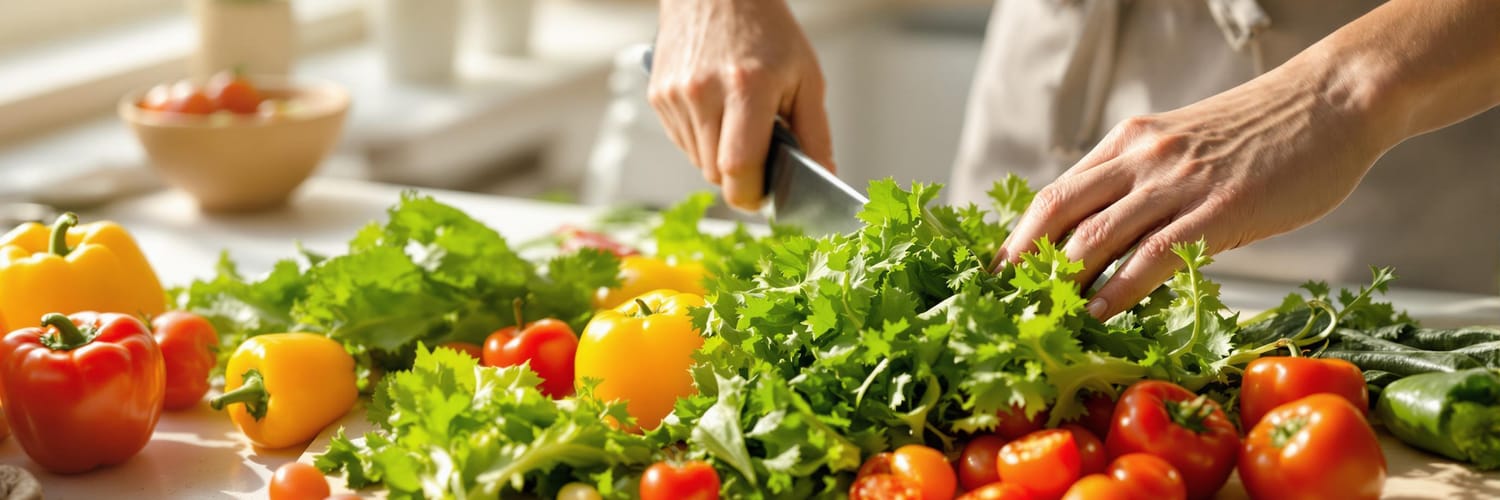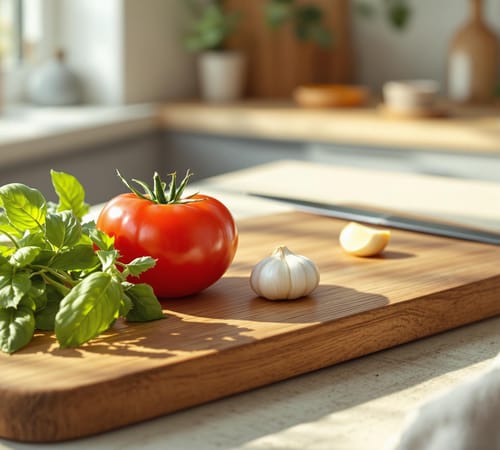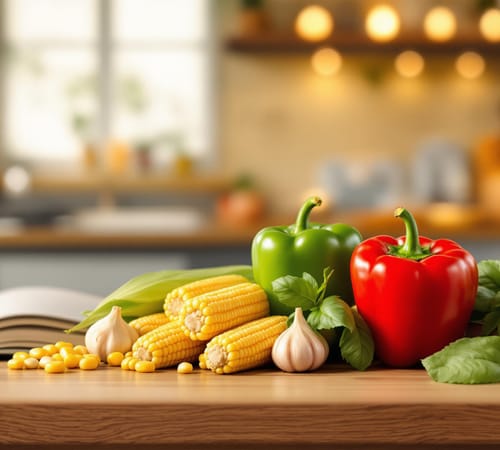Reducing food waste saves money, conserves resources, and helps the environment. Did you know 30-40% of the U.S. food supply is wasted, costing $218 billion annually? Here’s how you can make a difference:
- Plan smarter: Meal plan, shop with a list, and buy only what you need.
- Store food properly: Use the FIFO method, freeze items nearing expiration, and separate ethylene-producing fruits like bananas from other produce.
- Reimagine leftovers: Transform leftovers into new meals or freeze them for later.
- Understand labels: "Best By" and "Sell By" dates don’t always mean food is unsafe.
- Compost scraps: Turn unavoidable waste into nutrient-rich compost.
Small changes at home - like better storage, mindful shopping, and creative cooking - can reduce food waste by up to 50%. Let’s tackle this together!
Understanding Food Waste: Definition, Causes, and Statistics
What Is Food Waste?
Food waste happens when edible food is thrown away or left uneaten. This can include avoidable waste, like spoiled fruits, vegetables, or leftovers, and unavoidable waste, such as peels or bones. Unlike other types of waste, food waste carries an extra burden - it wastes all the resources that went into growing, transporting, and storing that food.
Why Does Food Waste Occur?
Food waste has many causes, especially in households, which are responsible for 48% of all wasted food in the United States [3].
| Cause | Common Examples | Impact |
|---|---|---|
| Poor Planning and Storage | Impulse purchases, no shopping list, improper containers, wrong storage temperature | Leads to overbuying and spoilage |
| Confusion Over Labels | Misinterpreting "best by" or "sell by" dates | Causes people to throw away edible food |
| Portion Mismanagement | Cooking too much, oversized servings | Results in uneaten leftovers |
Global Food Waste Statistics
In the United States, 30-40% of the food supply is wasted [3]. This waste creates both economic and environmental problems. For instance, when food waste ends up in landfills, it emits methane, a powerful greenhouse gas. Cutting back on food waste at home can help reduce methane emissions and lessen the impact on climate change.
Food scraps also make up a large share of landfill waste in many areas. Tackling these common causes - like better planning and smarter shopping - can help households play a key role in reducing food waste globally.
30 Ways to Reduce Food Waste
Effective Planning and Shopping
Reducing household food waste starts with smart planning and shopping habits. With a few simple strategies, you can save money and make better use of the food you buy.
Meal Planning to Cut Down Waste
Before heading to the store, take a quick inventory of your pantry and fridge. Build your meals around what you already have to prevent spoilage. Choose ingredients that can be used in multiple dishes, focus on seasonal produce, and plan realistic portions. Don’t forget to include leftovers in your meal plan - they can easily become the base for new dishes. Once your plan is set, shop with purpose to avoid overbuying.
Shopping Tips to Avoid Overbuying
Confusion around food date labels often leads to unnecessary waste. Understanding terms like 'Best By' (suggested quality), 'Use By' (peak freshness), and 'Sell By' (store stocking guide) can help you make informed choices. Many foods are still safe to eat after these dates, so buy only what you’ll realistically use.
Here are some tips for smarter shopping:
- Make a grocery list tied to your meal plan.
- Check food labels to ensure you’ll use items before they spoil.
- Buy “imperfect” produce at a discount - it’s just as good!
- Shop more often in smaller amounts to avoid stocking up unnecessarily.
Intentional shopping and understanding food labeling can help keep waste to a minimum. After shopping, proper storage and organization are essential to keeping your food fresh.
Organizing Your Pantry and Fridge
Use the 'first in, first out' (FIFO) method to ensure older items are used first. Label containers with dates, store fruits and vegetables correctly, and keep an inventory of what you have. Clear containers can make it easier to see what’s inside. This approach is especially helpful in places like King County, Washington, where food scraps and food-soiled paper make up over 16% of landfill waste [2].
For items nearing their best-by date, freezing is a great way to extend their shelf life and reduce waste.
Proper Food Storage Techniques
Storing food the right way helps keep it fresh longer, reduces waste, and saves you money by ensuring you actually use what you buy.
Storing Fruits and Vegetables
Different types of produce have different storage needs. For instance, fruits like apples, bananas, and avocados release ethylene gas, which speeds up ripening. Keep them separate from other fruits and vegetables. Potatoes and onions should also be stored apart in cool, dark places to avoid sprouting.
Here are some tips to keep your produce fresh:
- Use breathable bags to allow airflow.
- Line your refrigerator drawers with paper towels to absorb excess moisture.
- Store fresh herbs upright in a glass of water, like a bouquet.
- Keep citrus fruits in the crisper drawer of your fridge.
Making the Most of Your Freezer
Set your freezer to 0°F (-18°C) or lower to maintain food quality. When freezing leftovers or bulk items:
- Divide food into portions before freezing.
- Remove as much air as possible from bags or containers to prevent freezer burn.
- Freeze items quickly to lock in freshness.
For seasonal produce, blanch vegetables before freezing to help preserve their color and nutrients. To avoid clumping, freeze berries and leafy greens flat on a baking sheet first, then transfer them to containers.
Choosing the Right Containers and Packaging
The right storage materials can make a big difference:
- Glass jars work well for pantry staples and leftovers.
- Vacuum-sealed bags are great for freezing meats and bulk items without freezer burn.
- Breathable bags are best for fruits and vegetables that need airflow.
- Airtight plastic containers are ideal for dairy and deli items.
To stay organized, designate specific areas in your refrigerator for different food types, and keep the temperature below 40°F (4°C) for perishables. This setup helps you quickly see what needs to be used first, reducing waste.
Once you’ve mastered storage, you can focus on finding ways to use leftovers and ingredients creatively to cut down on waste even more.
Using Leftovers and Ingredients Efficiently
Reusing leftovers is a great way to cut down on food waste while keeping your meals interesting and diverse.
Turning Leftovers Into New Meals
Think outside the box when it comes to reusing leftovers. For example, roasted chicken can easily become tacos, sandwiches, or a hearty soup. Got leftover mashed potatoes? Turn them into crispy pancakes or a comforting shepherd's pie. Even plain pasta can shine as a cold salad when mixed with fresh veggies and a tangy vinaigrette.
Recipes for Common Leftover Items
Some ingredients often go to waste, but they’re surprisingly easy to repurpose. Check out these ideas:
| Ingredient | Ideas for Use |
|---|---|
| Stale Bread | Croutons, breadcrumbs, bread pudding |
| Overripe Bananas | Banana bread, smoothies, pancakes |
| Vegetable Scraps | Homemade stock, puréed sauces |
Experts from UMaine suggest setting up an "eat this first" section in your fridge to highlight items that need to be used soon [6]. This simple trick helps prevent food from being forgotten and wasted.
Freezing and Preserving Leftovers
Freezing is a smart way to extend the life of both meals and individual ingredients. To freeze effectively, make sure food is cooled, air is removed from containers, and everything is labeled and portioned.
Batch cooking is another handy tip. Prepare meals like soups, stews, or casseroles in large quantities, then freeze portions for later. These dishes reheat well and save time on busy days when you need a quick, homemade meal.
Keep leftovers in clear containers and store them at the front of your fridge. This makes them easy to spot and more likely to be used.
Once you’ve mastered using up leftovers, the next step is finding ways to reduce waste during the cooking process itself.
Minimizing Waste During Food Preparation
Making the Most of Ingredients
Get creative with your ingredients by finding ways to use scraps that would otherwise be thrown away. For example, vegetable trimmings can be simmered into flavorful broths, while other scraps can serve unique purposes in your kitchen.
Here are a few ideas to repurpose common scraps:
- Citrus peels: Use them to make natural cleaners or infuse oils with bright flavors.
- Eggshells: Turn them into seed starters for your garden.
- Herb stems: Add them to stocks or sauces for extra depth.
- Vegetable tops: Mix carrot greens or similar tops into salads or blend them into pestos.
Controlling Portions to Prevent Waste
Carefully measure portions to avoid cooking more food than necessary. Use tools like kitchen scales or measuring cups to keep things precise, and try not to prepare extra food "just in case." When cooking for a group, think about how much people typically eat and adjust your portions to avoid creating leftovers that might go uneaten.
Composting Scraps You Can’t Use
For those food scraps that can’t be repurposed, composting is a great solution. Items like eggshells and coffee grounds can break down into rich nutrients for soil instead of ending up in a landfill. Check out local composting programs or environmental resources for tips on how to start composting at home. It’s an easy way to give back to the earth while reducing waste.
Conclusion: The Impact of Small Changes
Small, consistent actions can significantly reduce food waste, especially since households are responsible for 48% of wasted food in the United States [3]. The choices we make at home play a crucial role in tackling this issue.
Simple steps like using the FIFO (First In, First Out) method can help prioritize older items and reduce waste. For instance, in New Zealand, better storage practices could save 29 million loaves of bread each year [5].
Cutting down on food waste also helps save money. By adopting mindful consumption habits, we can address the 30-40% of food wasted globally [7]. This not only eases the strain on our wallets but also supports a healthier planet.
Here are a few practical tips to get started:
- Freeze food that's close to expiring
- Keep perishable items in plain sight
- Track your food waste to refine your shopping and cooking habits [1]
Even small efforts like improving storage or planning meals can make a big difference. Plus, following circular economy principles shows how food waste can be repurposed into a resource rather than a problem [1]. These small changes can transform your kitchen into a more efficient space while contributing to a healthier environment.
FAQs
What are three ways to cut down on food waste?
Check your fridge often to spot items close to expiring. Use or freeze them quickly to avoid spoilage. If you have non-perishable items you won’t use, donate them to a local food pantry [1].
How can we keep food fresh for longer?
Storing food the right way can help it last much longer. Experts say vacuum sealing can increase the shelf life of perishable foods by up to five times [4]. Here are some tips:
- Keep food at the correct temperature.
- Use airtight containers for perishables like bread.
- Opt for frozen produce if fresh items might go unused.
"Track Your Trash... Try putting a pad of paper near your garbage and log what food you discard for two weeks." - Andrew Zimmern, Chef
What should I do with leftovers I don’t want?
Turn leftovers into new meals with these ideas:
- Cook extra portions on purpose and plan to use them later.
- Store leftovers in clear containers so they’re easy to spot.
- Set aside one night a week as "leftovers night."
- Get creative - use stale bread for croutons or vegetable scraps for stock [1].
"Getting into the habit of using up our leftovers is one way to have an impact on this important issue." - Bryn Mooth, Writer and Editor







